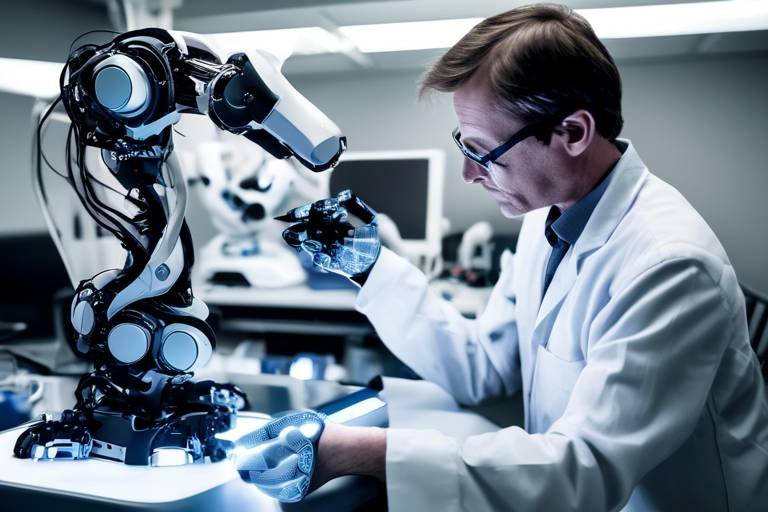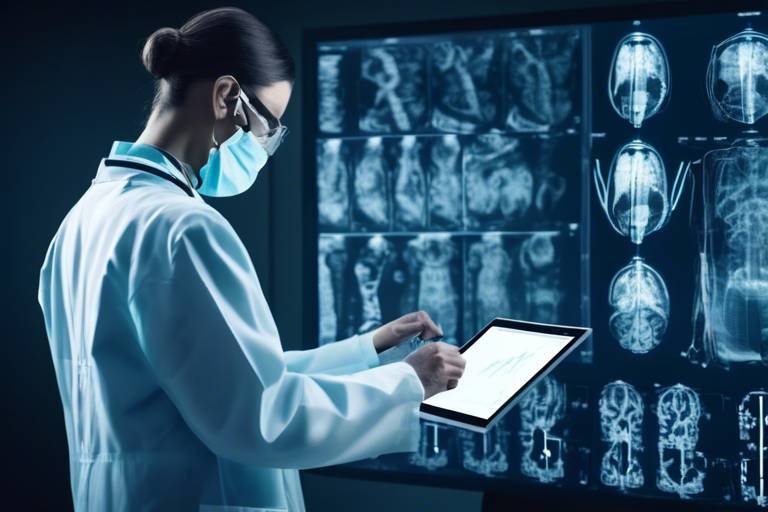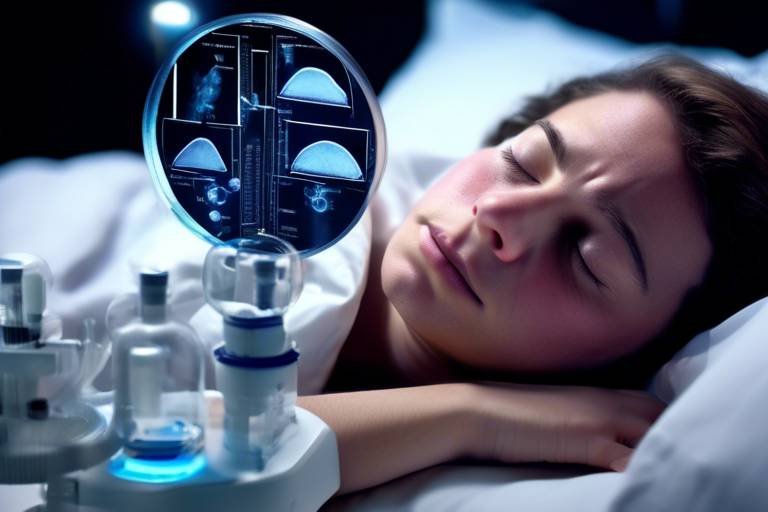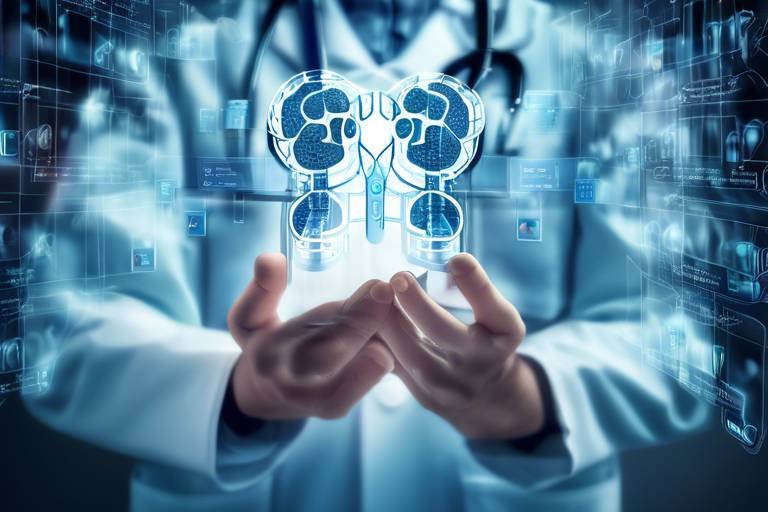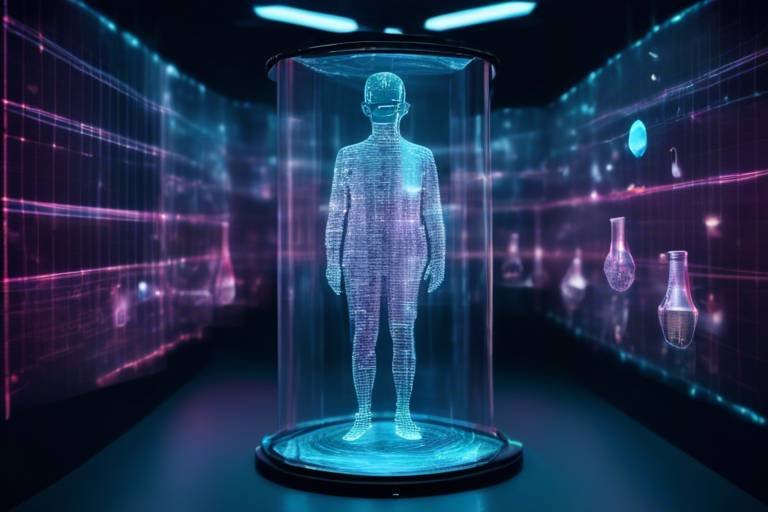How Robotics is Changing the Field of Genetics
The intersection of robotics and genetics is nothing short of revolutionary. Imagine a world where intricate genetic research is conducted with the precision of a finely tuned machine. That's the reality we are stepping into as robotics technology continues to evolve and integrate into the genetic landscape. This transformation is not just about making things faster; it's about enhancing the accuracy and efficiency of genetic research, paving the way for breakthroughs that could redefine how we understand and treat genetic disorders.
At its core, robotics in genetics is about automating repetitive tasks that once consumed countless hours of researchers' time. Think about the process of DNA sequencing—an essential step in understanding genetic material. Traditionally, this process required meticulous manual work, prone to human error and fatigue. However, with the advent of robotic systems, scientists can now perform these tasks with remarkable speed and precision. This means that researchers can spend less time on the nitty-gritty and more time on what truly matters: interpreting data and applying findings to real-world problems.
Moreover, the integration of robotics is not just limited to the lab. It extends into the realm of precision medicine, where treatments are tailored to individual genetic profiles. Robotics enables the analysis of vast data sets, allowing healthcare providers to develop personalized treatment plans that are far more effective than one-size-fits-all approaches. In this way, robotics is not only changing the methodology of genetic research but also revolutionizing how we approach patient care.
Automation is revolutionizing genetic research by increasing efficiency and accuracy. Robotic systems streamline DNA sequencing and analysis, allowing scientists to focus on interpreting results rather than performing repetitive tasks. The benefits of automation in genetics can be summarized as follows:
- Increased Throughput: Automated systems can process samples at a much faster rate than human hands ever could.
- Enhanced Accuracy: Robots do not tire, which means they deliver consistent results without the variations that can come from human error.
- Cost Efficiency: Although the initial investment in robotic systems can be high, the long-term savings from reduced labor costs and increased productivity are substantial.
This surge in automation is akin to upgrading from a horse-drawn carriage to a high-speed train; it changes the entire landscape of travel, or in this case, research. The implications are profound, and as automation continues to advance, we can only imagine the discoveries that await us.
Robotics plays a crucial role in precision medicine, enabling tailored treatments based on genetic profiles. Automated systems facilitate the analysis of large data sets, leading to more personalized healthcare solutions. In a world where no two individuals are exactly alike, the ability to customize treatments based on genetic information is nothing short of groundbreaking.
Robotic-assisted surgeries are becoming increasingly common in treating genetic disorders. These advanced systems provide surgeons with enhanced precision, reducing recovery times and improving patient outcomes. Imagine a surgeon operating with the aid of a robotic system that translates their movements into precise actions within the body—this is the future of surgical interventions for genetic conditions.
Robotic surgery offers numerous benefits, including:
- Minimized Invasiveness: Smaller incisions lead to less trauma for the patient.
- Reduced Scarring: The precision of robotic systems means that surgeries can be performed with minimal scarring.
- Shorter Hospital Stays: Patients often recover faster and can return home sooner.
Despite its benefits, robotic surgery faces challenges such as high costs, the need for specialized training, and potential technical failures. Addressing these issues is crucial for widespread adoption in genetic treatments. As with any new technology, the road to integration is not without its bumps.
The integration of robotics in genetics raises important ethical questions. Issues surrounding consent, data privacy, and the implications of genetic modifications must be carefully considered as technology advances. It’s essential to navigate these waters with caution, ensuring that while we push the boundaries of what is possible, we also uphold the values of respect and responsibility.
As technology continues to evolve, the future of robotics in genetics looks promising. Innovations such as AI-driven genetic analysis and enhanced robotic capabilities will likely reshape the landscape of genetic research and treatments. The combination of artificial intelligence and robotics is set to enhance genetic research, leading to groundbreaking discoveries and advancements in the field.
Imagine a world where AI algorithms can analyze genetic data more efficiently than any human ever could. This synergy between AI and robotics is not just a possibility; it’s an impending reality that will change the way we approach genetic research.
Robotics may significantly impact genetic engineering by enabling more precise gene editing techniques. This advancement could lead to new therapies for genetic disorders and improved agricultural practices. As we stand on the brink of this new era, the potential for innovation is limitless.
Q1: How is robotics currently being used in genetics?
Robotics is primarily used for automating tasks such as DNA sequencing, data analysis, and even in surgical procedures for genetic disorders.
Q2: What are the ethical concerns associated with robotics in genetics?
Key ethical concerns include consent, data privacy, and the implications of genetic modifications, all of which require careful consideration as technology advances.
Q3: What are the benefits of robotic surgery for genetic disorders?
Robotic surgery offers benefits such as minimized invasiveness, reduced scarring, and shorter recovery times, making it an attractive option for patients.
Q4: How might AI enhance the field of genetics?
AI can analyze large genetic data sets more efficiently, leading to faster discoveries and advancements in precision medicine and genetic engineering.
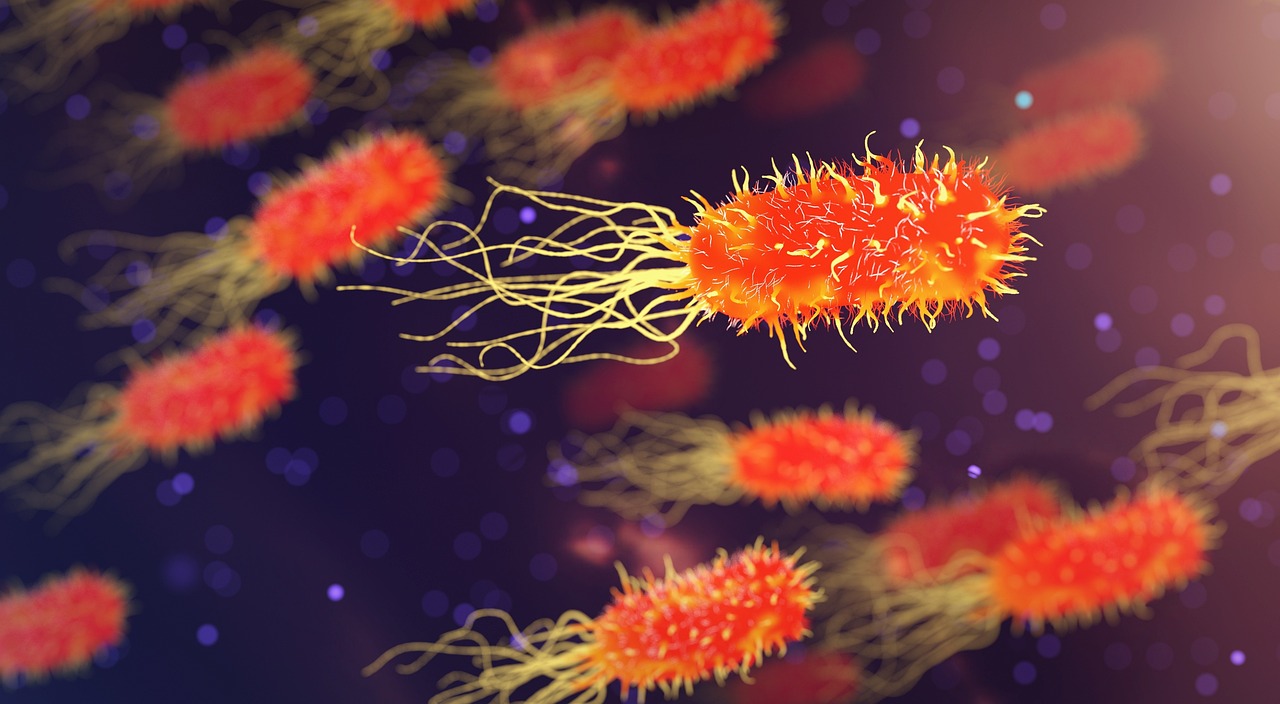
Automation in Genetic Research
Automation is revolutionizing genetic research, bringing a wave of efficiency and accuracy that was once unimaginable. Imagine a world where scientists can focus on unraveling the mysteries of DNA rather than getting bogged down in tedious, repetitive tasks. This is the reality that robotic systems are creating in laboratories across the globe. By streamlining processes such as DNA sequencing and analysis, these systems allow researchers to dedicate more time to interpreting their findings and less time to the nitty-gritty of data collection.
One of the most significant advancements in this field is the use of high-throughput screening technologies. These automated systems can analyze thousands of genetic samples simultaneously, drastically reducing the time it takes to gather results. For instance, consider a scenario where a research team is tasked with identifying genetic markers for a particular disease. With automation, they can process a vast number of samples in a fraction of the time it would take manually, leading to faster discoveries and potentially life-saving treatments.
Moreover, automation enhances the accuracy of genetic research. Human error is always a risk in laboratory settings, but robotic systems minimize this by performing tasks with precision that far exceeds human capability. This is particularly crucial in genetic research, where small errors can lead to significant misinterpretations of data. By employing robotics, laboratories can ensure that their results are not only faster but also more reliable.
To illustrate the impact of automation, let’s take a look at a few key areas where robotic systems are making a difference:
- DNA Sequencing: Automated sequencers can process samples at lightning speed, producing results that would take human technicians days or even weeks.
- Data Analysis: Advanced algorithms integrated with robotic systems can analyze complex genetic data sets, identifying patterns and correlations that might be missed by the human eye.
- Sample Preparation: Robots can handle the meticulous task of preparing samples for testing, ensuring consistency and reducing contamination risks.
As we look toward the future, the integration of robotics into genetic research is set to expand even further. With advancements in artificial intelligence and machine learning, we can expect to see even more sophisticated robotic systems capable of performing complex analyses that were previously thought to be the sole domain of human researchers. This evolution not only enhances the capabilities of genetic research but also opens the door to groundbreaking discoveries that could redefine our understanding of genetics.
In conclusion, automation in genetic research is not just a trend; it’s a transformative force that is reshaping the landscape of science. With its ability to increase efficiency, improve accuracy, and allow scientists to focus on innovation rather than routine tasks, robotics is paving the way for a new era in genetic research.

Precision Medicine and Robotics
In today's world, the intersection of robotics and precision medicine is nothing short of revolutionary. Imagine a healthcare landscape where treatments are not just one-size-fits-all but are tailored specifically to the unique genetic makeup of each individual. This is the promise of precision medicine, and robotics is playing a pivotal role in making this vision a reality. With the help of advanced robotic systems, healthcare providers can analyze vast amounts of genetic data with unparalleled speed and accuracy. This allows for a more nuanced understanding of diseases and the development of targeted therapies that are far more effective than traditional methods.
One of the standout features of robotics in precision medicine is the ability to automate complex tasks that were once the sole domain of highly trained professionals. For instance, robotic systems can perform high-throughput screening of genetic samples, drastically reducing the time it takes to identify potential genetic markers associated with specific diseases. This is akin to having a supercharged assistant who can sift through mountains of data in a fraction of the time it would take a human, allowing researchers to focus on what truly matters: interpreting the results and applying them to patient care.
Moreover, the integration of robotics into precision medicine is not just about efficiency; it's also about enhancing accuracy. Traditional methods of analyzing genetic data can be prone to human error, especially when dealing with complex datasets. Robotic systems, on the other hand, are programmed to perform tasks with a level of precision that is simply unattainable by human hands. For example, when it comes to sequencing DNA, robotic systems can ensure that every single base pair is analyzed correctly, which is crucial for developing effective treatments.
As we look to the future, the potential for robotics in precision medicine continues to expand. With advancements in artificial intelligence and machine learning, we can expect even more sophisticated robotic systems that can not only analyze genetic data but also predict outcomes based on that data. This predictive capability could revolutionize how we approach treatment plans, leading to proactive healthcare that anticipates problems before they arise.
However, while the benefits of incorporating robotics into precision medicine are immense, it is essential to consider the ethical implications that accompany these advancements. As we harness the power of robotics to delve deeper into genetic data, questions about data privacy, informed consent, and the potential for genetic discrimination become increasingly pertinent. It's crucial that as we embrace these technologies, we also establish robust frameworks to protect individuals' rights and ensure that the benefits of precision medicine are accessible to all.
In summary, robotics is not just a tool; it is a transformative force in the realm of precision medicine. By automating complex processes and enhancing the accuracy of genetic analyses, robotics paves the way for personalized treatments that can significantly improve patient outcomes. As we continue to explore this exciting frontier, the collaboration between robotics and medicine holds the promise of a healthier future for everyone.
- What is precision medicine? Precision medicine is an innovative approach to disease treatment and prevention that considers individual variability in genes, environment, and lifestyle for each person.
- How does robotics enhance precision medicine? Robotics enhances precision medicine by automating complex tasks, improving accuracy in data analysis, and enabling faster research and treatment development.
- What are the ethical concerns related to robotics in genetics? Ethical concerns include data privacy, informed consent, and potential genetic discrimination, which must be addressed as technology advances.

Robotic Surgery in Genetic Disorders
Robotic-assisted surgeries are not just a trend; they are becoming a vital part of how we treat genetic disorders. Imagine a surgeon with a pair of high-tech robotic hands that can perform intricate procedures with unmatched precision. This isn’t science fiction—it's the reality of modern medicine. These advanced systems allow surgeons to conduct operations that were once deemed too risky or complex, especially for patients with genetic conditions.
One of the most significant advantages of robotic surgery is the enhanced precision it offers. Traditional surgical methods can sometimes lead to unintended damage to surrounding tissues, which is especially concerning in delicate areas of the body. Robotic systems, equipped with state-of-the-art imaging and control technologies, can navigate these intricate landscapes with ease. This precision is crucial when dealing with genetic disorders that may require highly targeted interventions.
Moreover, recovery times are notably shorter for patients undergoing robotic surgeries. The minimally invasive nature of these procedures means that patients experience less trauma, resulting in quicker healing and less time spent in the hospital. For individuals coping with genetic disorders, this can make a world of difference, allowing them to return to their daily lives sooner and with less discomfort.
However, it’s essential to recognize that while robotic surgery presents numerous benefits, it also comes with its own set of challenges. High costs associated with robotic systems can be a barrier for many healthcare facilities, particularly in underserved areas. Additionally, the need for specialized training for surgical teams cannot be overlooked. Surgeons must be well-versed in both the technology and the specific genetic conditions they are treating. This training can be time-consuming and expensive, but it is vital for ensuring patient safety and optimal outcomes.
In summary, robotic surgery is revolutionizing the treatment of genetic disorders. With its unparalleled precision, reduced recovery times, and the ability to perform complex surgeries, it is paving the way for a new era in genetic medicine. As technology continues to evolve, we can expect even more innovative solutions that will further enhance surgical outcomes for patients facing genetic challenges.
- What is robotic surgery? Robotic surgery involves the use of robotic systems to assist surgeons in performing complex procedures with enhanced precision and control.
- How does robotic surgery benefit patients with genetic disorders? It offers minimized invasiveness, reduced recovery times, and improved surgical outcomes, which are particularly important for patients with genetic conditions.
- Are there risks associated with robotic surgery? Yes, like any surgical procedure, there are risks involved, including potential technical failures and the need for specialized training for surgical teams.

Benefits of Robotic Surgery
Robotic surgery is revolutionizing the way we approach surgical procedures, especially for patients with genetic disorders. One of the most significant advantages of this technology is its minimized invasiveness. Unlike traditional surgeries that often require large incisions, robotic systems use tiny instruments that can be maneuvered with incredible precision. This means that patients experience less trauma during the procedure, allowing for a smoother recovery process.
Another critical benefit is the reduction in scarring. With smaller incisions, patients are left with less visible scars, which can be a considerable concern for many individuals. This aesthetic advantage can significantly enhance a patient’s quality of life and body image post-surgery. Additionally, the precision of robotic surgery often leads to shorter hospital stays. Patients can return home sooner, reducing their time away from work and family, which is particularly important for those managing chronic genetic conditions.
Moreover, robotic-assisted surgeries are designed to enhance the surgeon's capabilities. These systems provide surgeons with a 3D view of the surgical area and allow for greater dexterity than the human hand can achieve. This heightened level of control can lead to fewer complications during surgery, which is a crucial factor when dealing with complex genetic disorders. The ability to perform intricate procedures with such accuracy not only improves patient outcomes but also enhances the overall efficiency of the healthcare system.
However, the benefits of robotic surgery extend beyond just the immediate physical advantages. Patients often report a faster return to normal activities and a quicker resumption of their daily routines. This is particularly vital for individuals who may be managing genetic disorders that require ongoing care and attention. With robotic surgery, patients can enjoy a better quality of life sooner, allowing them to focus on what truly matters—spending time with loved ones and engaging in activities they enjoy.
In summary, the benefits of robotic surgery are numerous and compelling. From reduced invasiveness and scarring to shorter hospital stays and improved surgical precision, this technology is paving the way for a new era in the treatment of genetic disorders. As robotic systems continue to evolve, we can anticipate even greater advancements in patient care and surgical outcomes.
- What is robotic surgery? Robotic surgery involves using robotic systems to assist surgeons in performing complex procedures with enhanced precision and control.
- How does robotic surgery benefit patients with genetic disorders? It offers reduced invasiveness, less scarring, shorter recovery times, and improved surgical outcomes.
- Are there risks associated with robotic surgery? Like all surgical procedures, there are risks, including potential technical failures and the need for specialized training for surgeons.
- Is robotic surgery more expensive than traditional surgery? While the initial costs may be higher, the long-term benefits, such as shorter hospital stays, can make it more cost-effective.

Challenges of Robotic Surgery
While robotic surgery offers a plethora of advantages, it also presents several challenges that must be addressed for it to become a mainstream solution in treating genetic disorders. One of the most significant hurdles is the high cost associated with robotic surgical systems. The initial investment for hospitals can be substantial, often running into millions of dollars. This financial burden can deter many healthcare facilities from adopting these advanced technologies, particularly in regions with limited resources.
Moreover, the operation of robotic surgical systems requires specialized training for surgeons and medical staff. Unlike traditional surgical methods, robotic surgery involves a steep learning curve. Surgeons must not only master the robotic system itself but also adapt their surgical techniques to work seamlessly with the technology. This necessitates ongoing training and practice, which can be time-consuming and costly.
Another concern is the potential for technical failures during surgery. Just like any complex machine, robotic systems can experience malfunctions or errors. While these incidents are relatively rare, they can have serious implications for patient safety. Surgeons must be prepared to quickly switch to traditional surgical methods in the event of a malfunction, which requires a high level of skill and confidence.
Additionally, there are ethical considerations surrounding the use of robotics in surgery. For instance, patients must be adequately informed about the risks and benefits of robotic surgery compared to conventional methods. The decision-making process can become complicated, especially when patients are faced with complex medical jargon and technology they may not fully understand.
Lastly, the integration of robotic systems into existing healthcare infrastructures can be challenging. Hospitals need to ensure that their operating rooms are equipped with the necessary technology to support robotic surgeries. This includes not just the robots themselves but also the software and systems for data management, which can lead to significant logistical challenges.
In summary, while robotic surgery holds immense potential for transforming the treatment of genetic disorders, it is essential to navigate these challenges thoughtfully. Addressing issues such as cost, training, technical reliability, ethical implications, and infrastructure readiness will be crucial for the successful integration of robotic surgery into mainstream medical practice.
- What are the main benefits of robotic surgery? Robotic surgery offers benefits such as reduced invasiveness, shorter recovery times, and enhanced precision during procedures.
- Are there risks associated with robotic surgery? Yes, like any surgical procedure, robotic surgery carries risks, including potential technical failures and the need for specialized training for surgeons.
- How does robotic surgery compare to traditional surgery? Robotic surgery typically allows for more precise movements and less tissue damage, leading to quicker recovery times compared to traditional methods.
- Is robotic surgery widely available? Availability can vary based on location and the resources of healthcare facilities, as the cost of robotic systems can be a barrier to widespread adoption.
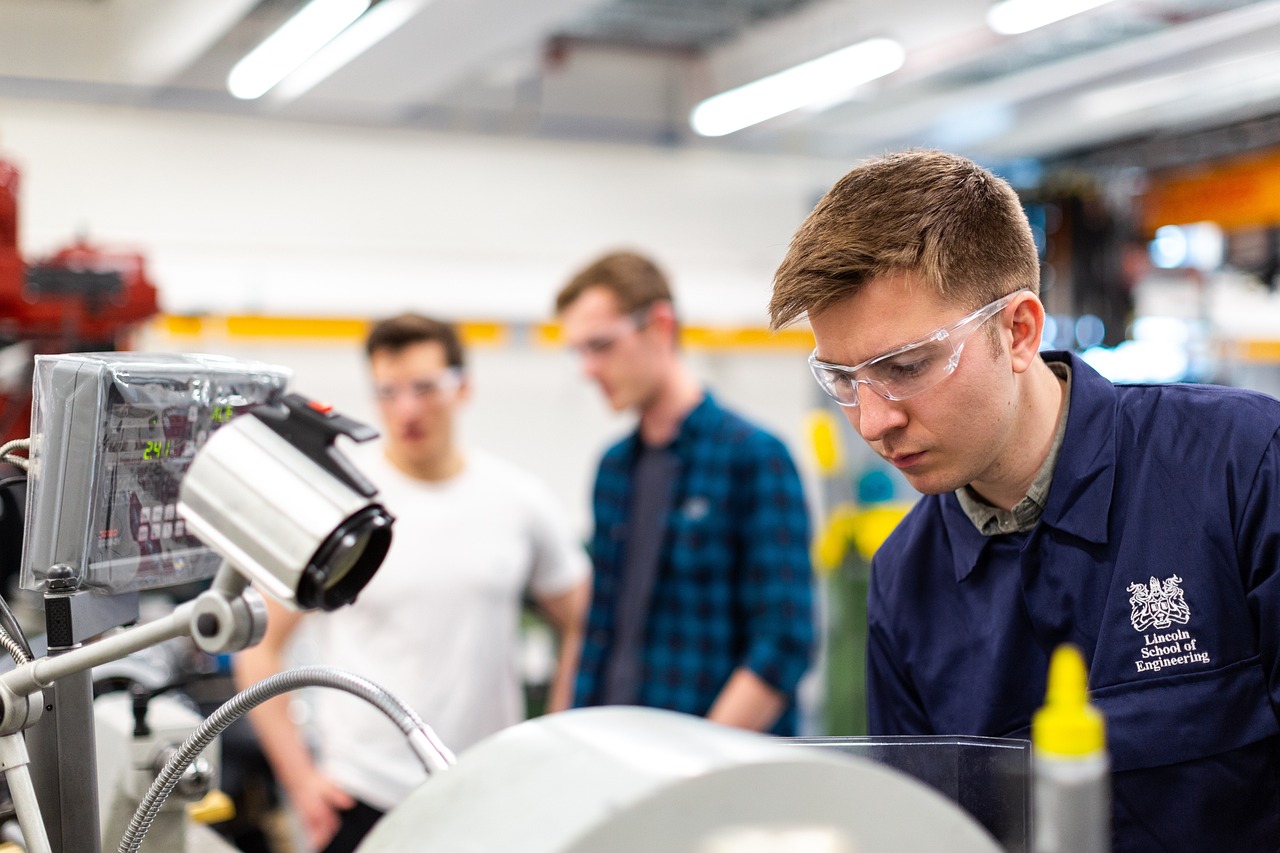
Ethical Considerations in Robotics and Genetics
The integration of robotics in the field of genetics is nothing short of revolutionary, but it also brings forth a plethora of ethical considerations that cannot be overlooked. As we dive deeper into the realm of genetic manipulation and automated systems, we must ask ourselves: what are the implications of these advancements on society? The intersection of technology and genetics raises critical questions regarding consent, data privacy, and the potential for genetic modifications that could alter the very fabric of human existence.
One of the primary ethical concerns revolves around informed consent. In traditional medical practices, obtaining consent from patients is a fundamental aspect of ethical treatment. However, with the involvement of robotic systems and AI in genetic research, the process of obtaining consent becomes more complex. How do we ensure that individuals fully understand the implications of their genetic data being analyzed by machines? Moreover, as automated systems become more sophisticated, the potential for misinterpretation of genetic information increases. This raises the question: can we trust robots to make decisions that affect human lives?
Another significant concern is data privacy. The vast amounts of genetic data generated and analyzed by robotic systems must be safeguarded to protect individuals from potential misuse. Imagine a world where your genetic information is easily accessible to corporations or hackers—this scenario is not as far-fetched as it seems. As the saying goes, "with great power comes great responsibility." Therefore, it is vital to establish robust data protection laws and ethical guidelines to ensure that genetic information remains confidential and secure.
Furthermore, the implications of genetic modifications cannot be ignored. As robotics enables more precise gene editing techniques, we tread on a delicate ethical landscape. Should we play the role of "God" and alter human genetics? This question is not just philosophical; it has real-world ramifications. The potential for creating "designer babies" or enhancing human traits raises concerns about equality and accessibility. Will only the wealthy have access to these advancements, leading to a new form of genetic inequality?
To address these ethical dilemmas, it is essential to foster ongoing discussions among scientists, ethicists, and the public. Establishing a framework that guides the ethical use of robotics in genetics is critical. Here are some considerations that should be part of this framework:
- Transparency: All processes involving genetic data should be transparent to ensure trust and understanding.
- Accountability: There must be clear accountability for decisions made by robotic systems in genetic research.
- Public Engagement: Engaging the public in discussions about genetic advancements can help address concerns and misconceptions.
In conclusion, while the marriage of robotics and genetics holds tremendous promise, it is accompanied by significant ethical challenges. As we navigate this uncharted territory, it is crucial to prioritize ethical considerations, ensuring that advancements in genetics benefit all of humanity rather than create further divides. The future of genetics is bright, but it is our responsibility to steer it in a direction that aligns with our moral values and societal norms.
Q1: What are the main ethical concerns regarding robotics in genetics?
A1: The main ethical concerns include informed consent, data privacy, and the implications of genetic modifications.
Q2: How can we ensure data privacy in genetic research?
A2: Establishing robust data protection laws and ethical guidelines is essential to safeguard genetic information from misuse.
Q3: Is there a risk of creating genetic inequality with advancements in genetics?
A3: Yes, there is a risk that only the wealthy may have access to genetic enhancements, leading to a new form of inequality.

Future Trends in Robotics and Genetics
As we gaze into the horizon of technological advancements, the synergy between robotics and genetics is poised to transform the medical field in unprecedented ways. Imagine a future where robotic systems not only assist in surgeries but also play a pivotal role in diagnosing and treating genetic disorders with pinpoint accuracy. This isn’t just a distant dream; it’s the trajectory we’re on. With rapid advancements in artificial intelligence (AI) and machine learning, the potential for robotics to revolutionize genetic research and treatments is enormous.
One of the most exciting trends is the integration of AI-driven genetic analysis. By harnessing the power of AI, robotic systems can analyze vast amounts of genetic data at lightning speed. This capability will enable scientists to uncover patterns and correlations that were previously hidden, leading to groundbreaking discoveries in our understanding of genetics. For instance, consider how AI algorithms can sift through millions of genetic sequences, identifying mutations associated with specific diseases. This level of efficiency can accelerate research timelines, bringing us closer to effective treatments.
Furthermore, the future of robotics in genetics is not just about data analysis; it also encompasses the advancement of gene editing techniques. Robotics equipped with precise tools could allow researchers to perform genetic modifications with unparalleled accuracy. Imagine a scenario where a robotic arm can edit genes at a cellular level, correcting mutations that cause hereditary diseases. This capability could pave the way for innovative therapies that target the root causes of genetic disorders, rather than merely alleviating symptoms.
To illustrate the potential impact of these trends, let’s consider a few key areas where robotics is expected to make significant strides:
| Area of Impact | Description |
|---|---|
| AI in Genetic Research | Robotics combined with AI will enhance the speed and accuracy of genetic data analysis, leading to faster breakthroughs. |
| Precision Gene Editing | Robotic systems will enable more precise and controlled gene editing, improving therapeutic outcomes. |
| Automated Diagnostics | Robotics will facilitate automated genetic testing, allowing for quicker and more reliable diagnoses. |
Moreover, the development of smart robotic systems that can learn and adapt will further enhance their capabilities in genetics. These systems could potentially recognize patterns in genetic data and suggest new avenues for research, acting as co-researchers alongside human scientists. As we continue to explore the intersection of robotics and genetics, we can expect to see innovations that not only improve patient care but also redefine our understanding of human biology.
However, it’s essential to approach these advancements with a sense of responsibility. As we embrace the potential of robotics in genetics, we must also consider the ethical implications. Questions surrounding data privacy, consent, and the potential for misuse of genetic information will need to be addressed. By fostering a dialogue around these issues, we can ensure that the future of robotics in genetics is not only innovative but also ethical and inclusive.
In conclusion, the future trends in robotics and genetics are undeniably exciting. With the promise of AI integration, enhanced gene editing techniques, and automated diagnostics, we stand on the brink of a new era in healthcare. As we continue to innovate, let’s remain vigilant about the ethical considerations that accompany these advancements, ensuring that they benefit all of humanity.
- What role does AI play in genetic research? AI helps analyze large datasets quickly, uncovering patterns that can lead to new discoveries.
- How can robotics improve gene editing? Robotics can provide precise control over gene editing techniques, enhancing accuracy and reducing errors.
- What are the ethical concerns with robotics in genetics? Issues such as data privacy, consent, and the implications of genetic modifications are critical to address as technology evolves.

AI Integration with Robotics
As we dive deeper into the fascinating intersection of artificial intelligence (AI) and robotics, it's clear that this synergy is not just a passing trend; it's a revolution that is reshaping the landscape of genetic research. Imagine a world where robots, powered by AI, can analyze genetic data with a speed and accuracy that far surpasses human capabilities. This is not science fiction—it's happening right now!
AI integration with robotics is enhancing the efficiency of genetic research in several ways. For starters, AI algorithms can sift through massive data sets, identifying patterns and anomalies that might escape the naked eye. This capability allows researchers to make groundbreaking discoveries at an unprecedented pace. The combination of AI's analytical power and robotics' precision creates a formidable force in the lab, enabling scientists to focus on the creative aspects of their work rather than getting bogged down by tedious data entry and analysis.
Moreover, the role of AI in robotics extends beyond mere data analysis. In genetic engineering, for instance, AI can assist in designing gene editing strategies that are more precise and effective. By utilizing machine learning algorithms, robots can predict the outcomes of genetic modifications, allowing researchers to experiment with confidence. This predictive capability is akin to having a crystal ball that helps scientists foresee the implications of their work before they even begin.
To illustrate the impact of AI integration in robotics within genetics, consider the following table:
| Aspect | Traditional Methods | AI-Enhanced Robotics |
|---|---|---|
| Data Analysis Speed | Hours to Days | Minutes to Hours |
| Accuracy | Human Error Prone | High Precision |
| Pattern Recognition | Manual Interpretation | Automated Detection |
| Gene Editing Design | Trial and Error | Predictive Modeling |
This table highlights just how transformative AI integration can be in the field of genetics. By reducing the time and potential for error in data analysis and gene editing, researchers can accelerate the pace of scientific discovery. Imagine the possibilities when geneticists can harness this technology to develop new therapies for genetic disorders or even improve crop resilience in agriculture!
However, while the benefits are immense, we must also tread carefully. The ethical implications of AI in genetics are significant. Questions arise about data privacy, consent, and the potential for misuse of genetic information. As we embrace these technological advancements, it’s crucial to establish frameworks that ensure responsible use and protect individuals' rights.
In conclusion, the integration of AI with robotics is not just enhancing the capabilities of genetic research; it is fundamentally changing how we approach problems in this field. As we continue to explore this exciting frontier, one thing is certain: the future of genetics is bright, and AI-powered robotics will play a pivotal role in shaping it.
- What is the role of AI in genetic research?
AI helps analyze large data sets quickly and accurately, enabling researchers to identify patterns and make discoveries faster than traditional methods. - How does robotics improve genetic engineering?
Robotics enhances precision in gene editing, allowing for more effective and targeted interventions. - What are the ethical concerns surrounding AI and genetics?
Key concerns include data privacy, consent for genetic testing, and the potential misuse of genetic information.
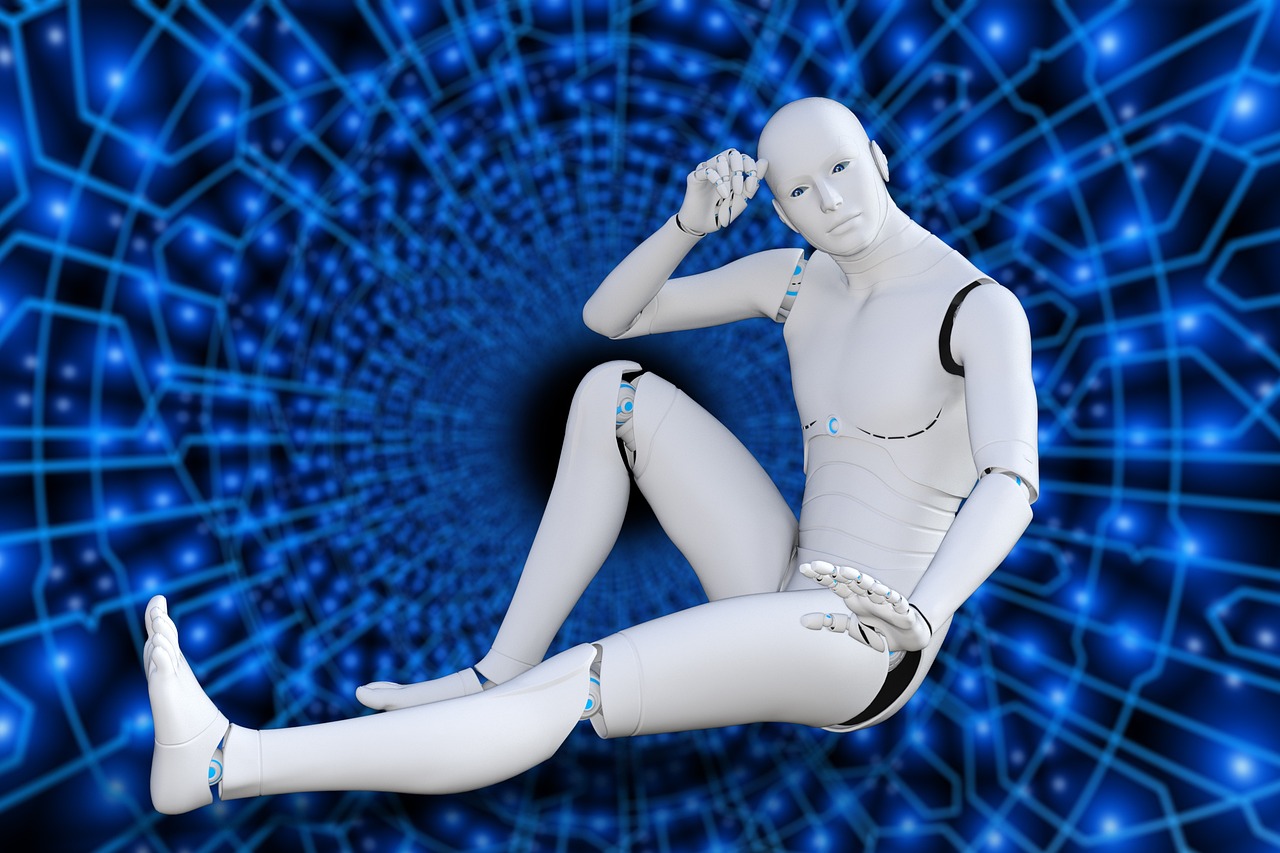
Potential Impact on Genetic Engineering
The realm of genetic engineering is on the brink of a revolution, and robotics is at the forefront of this transformation. Imagine a world where scientists can manipulate genes with the precision of a skilled artisan, crafting new solutions to age-old problems. Robotics is not just a tool; it is becoming a partner in this intricate dance of DNA manipulation. With the aid of advanced robotic systems, researchers can now perform complex genetic edits with unparalleled accuracy, minimizing the risk of errors that can arise from traditional methods.
One of the most exciting aspects of this integration is the potential for gene editing technologies like CRISPR to be enhanced by robotic automation. Robots can handle the repetitive and meticulous tasks associated with preparing samples, running experiments, and analyzing results. This allows scientists to focus on the creative and analytical aspects of their work, leading to faster discoveries and innovations. For instance, robotic systems can manage multiple samples simultaneously, increasing throughput and enabling high-throughput screening of genetic modifications.
Moreover, the precision offered by robotics can significantly improve the outcomes of genetic interventions. Consider the impact of robotic-assisted gene editing in agriculture. With the ability to edit plant genomes accurately, we can develop crops that are more resistant to diseases, pests, and environmental stresses. This not only enhances food security but also reduces the need for chemical pesticides, promoting a more sustainable approach to farming.
In the medical field, the implications are equally profound. Robotic systems can facilitate the development of gene therapies aimed at treating genetic disorders. By ensuring that gene edits are made precisely at the target location within the genome, the risk of off-target effects—where unintended parts of the genome are altered—is greatly reduced. This precision is crucial in developing therapies that are both safe and effective.
However, as we embrace these technological advancements, it is essential to consider the broader implications. The ability to edit genes with such precision raises ethical questions regarding designer genes and the potential for unintended consequences. We must tread carefully, ensuring that we maintain a balance between innovation and ethical responsibility. As we push the boundaries of what is possible with genetic engineering, ongoing dialogue among scientists, ethicists, and the public will be vital.
In summary, the integration of robotics into genetic engineering is poised to reshape the landscape of science and medicine. With the capability to perform precise gene edits and manage complex experiments, robotics is not just enhancing our capabilities; it is expanding the horizon of what we can achieve. The future holds exciting possibilities, but with them comes the responsibility to navigate the ethical implications of our newfound powers.
- What is genetic engineering? Genetic engineering involves manipulating an organism's DNA to achieve desired traits.
- How does robotics enhance genetic engineering? Robotics increases precision and efficiency in gene editing processes, allowing for more accurate results.
- What are the ethical concerns surrounding genetic engineering? Ethical concerns include the potential for designer genes, consent issues, and the long-term effects of genetic modifications.
- Can robotics help in agricultural advancements? Yes, robotic systems can facilitate the development of genetically modified crops that are more resilient and sustainable.
- What are the future trends in robotics and genetics? Future trends include AI integration, enhanced robotic capabilities, and more personalized genetic therapies.
Frequently Asked Questions
- How is robotics improving genetic research?
Robotics is revolutionizing genetic research by automating tedious tasks like DNA sequencing and analysis. This automation increases efficiency and accuracy, allowing scientists to focus on interpreting results instead of getting bogged down by repetitive work. Imagine having a super-efficient assistant that never tires—this is what robotics brings to the table!
- What role does robotics play in precision medicine?
Robotics is essential for precision medicine as it enables tailored treatments based on individual genetic profiles. Automated systems can analyze vast amounts of genetic data quickly, leading to healthcare solutions that are personalized for each patient. Think of it as having a custom-tailored suit that fits perfectly—robotics helps create that fit in medical treatments.
- What are the benefits of robotic surgery for genetic disorders?
Robotic surgery offers numerous benefits, such as minimized invasiveness, reduced scarring, and shorter hospital stays. For patients with genetic conditions requiring surgical intervention, these advantages can significantly enhance recovery and overall outcomes. It's like upgrading from a regular car to a sleek sports model—everything just runs smoother and faster!
- What challenges does robotic surgery face?
Despite its many benefits, robotic surgery encounters challenges like high costs, the necessity for specialized training, and potential technical failures. Addressing these hurdles is vital for broader acceptance and implementation in treating genetic disorders. It's a bit like trying to get everyone to switch to electric cars; there are bumps along the road that need smoothing out.
- What ethical considerations arise with robotics in genetics?
The integration of robotics into genetics raises significant ethical questions, including issues of consent, data privacy, and the implications of genetic modifications. As technology advances, these concerns must be addressed to ensure responsible use. It's like having a powerful tool—how we wield it matters greatly!
- What future trends can we expect in robotics and genetics?
The future of robotics in genetics looks bright, with innovations like AI-driven genetic analysis and enhanced robotic capabilities on the horizon. These advancements are likely to reshape genetic research and treatments, pushing the boundaries of what's possible. Picture a world where every genetic disorder has a tailored solution—exciting, right?
- How will AI integration with robotics impact genetic research?
The combination of artificial intelligence and robotics is set to supercharge genetic research. AI algorithms can analyze genetic data more efficiently than ever, leading to groundbreaking discoveries and advancements. It's akin to having a brilliant detective on your team, solving complex cases with ease!
- What potential impact might robotics have on genetic engineering?
Robotics could significantly enhance genetic engineering by enabling more precise gene editing techniques. This advancement has the potential to lead to new therapies for genetic disorders and improved agricultural practices. Think of it as fine-tuning a recipe to perfection—robotics helps ensure every ingredient is just right!

